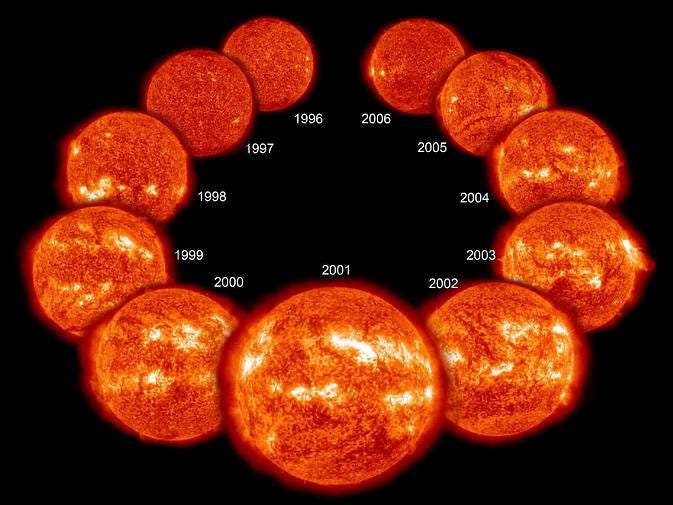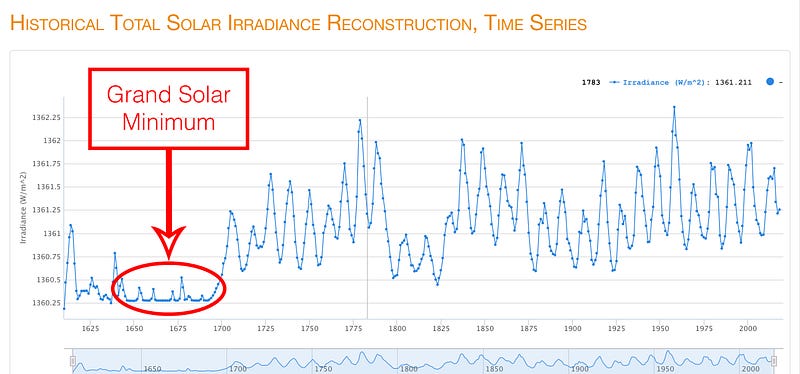The Sun's Current Calm: Debunking Myths of Catastrophe
Written on
Chapter 1: Understanding the Sun's Activity
On May 15, 2020, the sun was remarkably tranquil, showing no sunspots or significant solar flares. Image Credit: NASA/SDO. Contrary to popular belief, the sun's current phase is part of a typical cycle, and there is no impending doom related to this inactivity. While various threats to humanity exist, solar-induced disasters are not among them. Feel free to take a deep breath and resume your normal activities.

Eleven years of solar activity are captured in a series of images, showcasing the transition from peak to low activity. Image Source: NASA.
So, you’re still with me? Recently, someone inquired whether the sun's current low activity could lead to an ice age and widespread chaos, a notion fueled by sensational online stories. These claims tend to resurface every few years, each time with a different twist. One particularly misleading article from a British tabloid stated, "The sun has gone into a period of ‘lockdown’ which could cause freezing weather, earthquakes and famine, say scientists." This headline is both alarming and misleading, lacking credible sources or substantial evidence.
Let’s shed some light on this subject. NASA clarified in February that “there is no impending ‘ice age’ or ‘mini ice age’ due to a predicted decrease in solar energy output over the coming decades.” The situation remains unchanged.
Section 1.1: The Natural Solar Cycle
The sun undergoes a natural cycle roughly every 11 years, fluctuating between periods of high and low activity. During active years, sunspots and solar storms are more common; during quieter years, they are scarce. Currently, we are in a trough, transitioning from Solar Cycle 24, which was notably mild, to Solar Cycle 25. The mildness of Cycle 24 has led some researchers to speculate about potential future cycles, similar to the Grand Solar Minimum that occurred between 1650 and 1715.
This historical low period is believed to have contributed to the Little Ice Age, which spanned from around 1300 to the mid-1800s. However, it is crucial to note that this cooling was not uniform globally, and studies confirm that various factors contributed to these climate changes.

Section 1.2: Myths and Realities of Solar Influence
Now, let’s address the question: Could prolonged inactivity from the sun lead to global freezing? Here are four reasons why this is highly improbable:
- No Evidence of a Grand Solar Minimum: Current data do not suggest we are heading towards another Grand Solar Minimum; such claims remain speculative.
- Historical Context: The Little Ice Age predates the Grand Solar Minimum and was influenced by multiple factors, including heightened volcanic activity that released cooling aerosols into the atmosphere.
- Minimal Variability: Satellite measurements over the past 40 years indicate that solar energy reaching Earth has fluctuated by less than 0.1 percent, a change that is relatively minor.
- Greenhouse Gas Effects: NASA points out that any cooling resulting from a Grand Solar Minimum would be overshadowed by the warming effects of greenhouse gases from human activities, which are estimated to be six times greater.
Furthermore, claims linking solar activity to earthquakes lack scientific support. The U.S. Geological Survey states, “It has never been demonstrated that there is a causal relationship between space weather and earthquakes.”
Addressing famine concerns, any speculation about solar cycles affecting food supplies lacks substantial evidence. While long-term droughts are an issue, particularly in the U.S. Southwest, they are more likely tied to historical climate cycles and global warming rather than solar activity.
Chapter 2: Future Concerns and Solar Activity
The first video titled "Our Sun is Becoming Too Active too Soon" discusses the sun's cycles and the implications of increased solar activity.
As we look to the future, there is a legitimate concern about solar activity as we approach the peak of the next cycle. Strong solar storms can potentially disrupt satellites and power grids here on Earth. The most severe solar storm recorded occurred in 1859 and, while it didn’t affect modern power grids, it did disrupt telegraph systems and even caused fires.
However, such a scenario is unlikely to occur during periods of low solar activity, and it certainly would not trigger an ice age.
The second video titled "How to Stay Calm in Any Storm (Plus Free Workshop Invite!)" offers insights into maintaining composure during challenging times.
In conclusion, while the sun may be calm now, the potential threats from future solar activity warrant attention, but they do not include fears of an impending ice age. Instead, it's essential to focus on more immediate concerns that affect our daily lives.